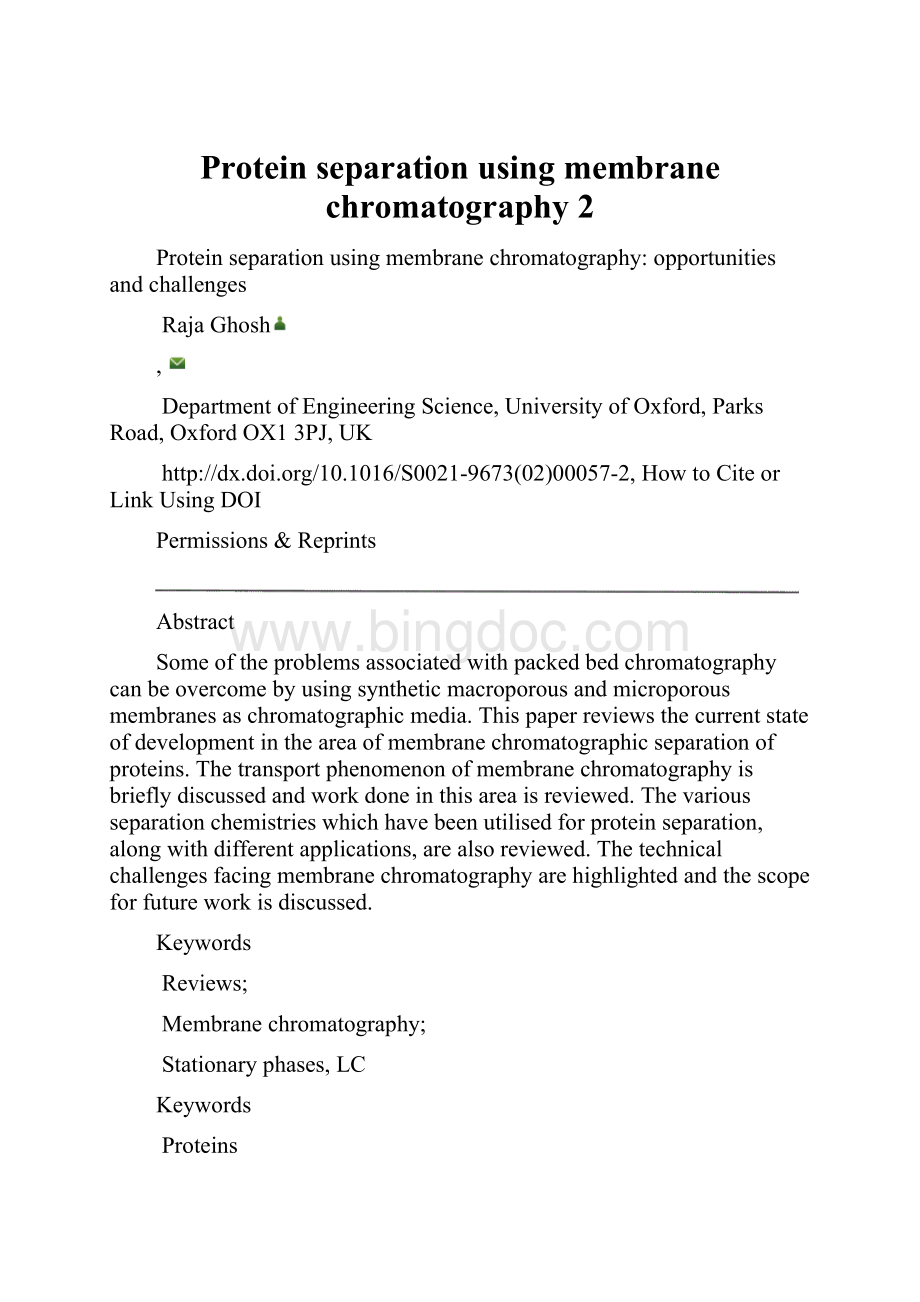Protein separation using membrane chromatography 2.docx
《Protein separation using membrane chromatography 2.docx》由会员分享,可在线阅读,更多相关《Protein separation using membrane chromatography 2.docx(29页珍藏版)》请在冰点文库上搜索。

Proteinseparationusingmembranechromatography2
Proteinseparationusingmembranechromatography:
opportunitiesandchallenges
RajaGhosh
DepartmentofEngineeringScience,UniversityofOxford,ParksRoad,OxfordOX13PJ,UK
http:
//dx.doi.org/10.1016/S0021-9673(02)00057-2,HowtoCiteorLinkUsingDOI
Permissions&Reprints
Abstract
Someoftheproblemsassociatedwithpackedbedchromatographycanbeovercomebyusingsyntheticmacroporousandmicroporousmembranesaschromatographicmedia.Thispaperreviewsthecurrentstateofdevelopmentintheareaofmembranechromatographicseparationofproteins.Thetransportphenomenonofmembranechromatographyisbrieflydiscussedandworkdoneinthisareaisreviewed.Thevariousseparationchemistrieswhichhavebeenutilisedforproteinseparation,alongwithdifferentapplications,arealsoreviewed.Thetechnicalchallengesfacingmembranechromatographyarehighlightedandthescopeforfutureworkisdiscussed.
Keywords
Reviews;
Membranechromatography;
Stationaryphases,LC
Keywords
Proteins
1.Introduction
Chromatographyisbyfarthemostwidelyusedtechniqueforhigh-resolutionseparationandanalysisofproteins.Theseprocessesaretraditionallycarriedoutusingpackedbeds,whichhaveseveralmajorlimitations.Thepressuredropacrossapackedbedisgenerallyhighandtendstoincreaseduringaprocessduetothecombinedeffectsofbedconsolidation(causedbymediadeformation),andcolumnblindingcausedbyaccumulatedcolloidalmaterial.Anothermajorlimitationwithconventionalchromatographicbioseparationprocesses,particularlythoseemployingsoftchromatographicmedia,isthedependenceonintra-particlediffusionforthetransportofsolutemoleculestotheirbindingsiteswithintheporesofsuchmedia(seeFig.1).Thisincreasestheprocesstimesincetransportofmacromoleculesbydiffusionisslow,andparticularlysowhenitishindered.Consequently,therecoveryliquidvolume(neededforelution)alsoincreases.Channelling,i.e.theformationofflowpassagesduetocrackingofthepackedbed,isamajorproblem.Thisresultsinshort-circuitingofmaterialflow,leadingtopoorbedutilisation.Otherproblemsincluderadialandaxialdispersionlimitationsarisingfromtheuseofconventionalpolydispersemedia.Someofthesefactorsandthefactthatthetransportphenomenoniscomplicatedmakescale-upofpackedbedchromatographicprocessesdifficult.
Fig.1.Solutetransportinpackedbedchromatographyandmembranechromatography.
Figureoptions
Someofthelimitationsofpackedbedchromatographyhavebeenovercomebyusingnewlydevelopedmonodisperse,non-porous,rigidchromatographicmedia(e.g.Refs.[1]and[2]).However,thesemediaaregenerallyexpensiveandthesolutebindingcapacityisgreatlyreducedsincebindingcannowonlytakeplaceontheexternalsurfaces.Alsowiththesematerials,theproblemofhigh-pressuredropstillpersists.
Aradicallydifferentapproachtoovercomethelimitationsassociatedwithpackedbedsistousesyntheticmicroporousormacroporousmembranesaschromatographicmedia(e.g.Refs.[3],[4],[5]and[6]).Inmembranechromatographicprocessesthetransportofsolutestotheirbindingsitestakesplacepredominantlybyconvection(seeFig.1),therebyreducingbothprocesstimeandrecoveryliquidvolume.Thebindingefficiencyisgenerallyindependentofthefeedflow-rateoverawiderangeandthereforeveryhighflow-ratesmaybeused.Thepressuredropisalsosignificantlylowerthanwithpackedbeds.Anothermajoradvantageofmembraneadsorbersistherelativeeaseofscale-upwhencomparedwithpackedbeds.However,thispotentialhasnotbeenfullyutilisedasyetinthebioprocessindustry.Membranechromatographyisparticularlysuitableforlargerproteins(i.e.Mr>250 000).Suchproteinsrarelyenterporespresentinparticulatechromatographicmediaandonlybindontheexternallyavailablesurfaceareaofsuchmedia.Therefore,forlargerproteins,thesurfaceareaavailableforbindingissignificantlygreaterwithmembranes.Thebindingcapacityofmembraneadsorbersforsmallerproteinsisgenerallylowerthanwithconventionalgel-basedmedia,butsignificantlyhigherthanwithmonodisperse,non-porous,rigidmedia.
Membranechromatographicdevicesaregenerallyeasierandcheapertomass-produce.Thismakesitpossibletohavedisposablemembraneadsorbers.Thesedevicescanbeuseduntilthedesirableproperties(i.e.hydraulicpermeability,bindingcapacity,selectivityandresolvingpower)aremaintained.Oncetheyceasetofunctionproperlythesedevicescanbereplaced.Thistypeofflexibilityeliminatestherequirementforcleaningandequipmentrevalidation.
Differentseparationchemistriesareutilisedinmembranechromatographyofproteins.Somemembranesalreadyinuseforothertypesofmembraneprocesses(e.g.microfiltration)havebeenfoundtobesuitableaschromatographicmedia.However,inmostcasestheseavailablemembraneshavebeenmodifiedtomakethemmoresuitableforuseasmembraneadsorbers.Novelsyntheticmembraneshavealsobeendeveloped.Anotheralternativetopackedbedchromatography,whichhascertainsimilaritieswithmembranechromatography,isbasedontheuseofmonolithcolumns.Thesecolumnsarepreparedusingrod-shapedporousstructuresthroughwhichconvectiveflowofmobilephasecantakeplace.Themainadvantagesofmonolithcolumnsaresimilartothoseformembranechromatography.However,monolithsdifferfrommembranesintermsofmaterialofconstructionandmorphology.Whileamembranebydefinitionisabarrierinwhichthelateraldimensionfarexceedsthelongitudinaldimension,theconverseisprobablytruewithmonoliths.Monolithsareperhapsmoresimilartopackedbedchromatographiccolumnsthantomembranes.
Inthisreviewarticle,thecurrentstateofdevelopmentintheareaofmembranechromatographyisdiscussed.Publishedliteratureintheareaofmembranechromatographyofproteinsisreviewed(e.g.Refs.[3],[4],[5],[6],[7],[8],[9],[10],[11],[12],[13],[14],[15],[16],[17],[18],[19],[20],[21],[22],[23],[24],[25],[26],[27],[28],[29],[30],[31],[32],[33],[34],[35],[36],[37],[38],[39],[40],[41],[42],[43],[44],[45],[46],[47],[48],[49],[50],[51],[52],[53],[54],[55],[56],[57],[58],[59],[60],[61],[62],[63],[64],[65],[66],[67],[68],[69],[70],[71],[72],[73],[74],[75],[76],[77],[78],[79],[80],[81],[82],[83],[84],[85],[86],[87],[88],[89],[90],[91],[92],[93],[94],[95],[96],[97],[98],[99],[100],[101],[102],[103],[104],[105],[106],[107],[108]and[109]).Potentiallimitationsofmembranechromatographyarealsohighlighted.Thewideracceptanceofthistechnologydependslargelyonfindingsolutionstotheselimitations.
2.Transportphenomenaofmembranechromatography
Theadvantageofmembranechromatographyliesinthepredominanceofconvectivematerialtransport.However,asevidentfromFig.1,diffusivetransportisnottotallyabsent.Thepredominanceofconvectionalonedoesnotnecessarilyguaranteeefficiency.Convectiveflowofinappropriatetypecanbeaseriousdisadvantage.Flowdistributionisamajorconcerninchromatographicandindeedmosttypesofseparationprocesses.Rationaldesignofthemembranechromatographicprocessandequipmentispossibleonlywhenthetransportphenomenainvolvedareproperlyunderstood.However,itmaybeworthmentioningthat,inmanychromatographicprocesses,particularlythoserelyingonaffinity-typeinteractions,thebindingkineticsmaybelimiting.Insuchprocesses,improvementintransportphenomenaisnotlikelytoresultinsignificantimprovementinprocessefficiency.
Generallyspeaking,threetypesofmembraneadsorbersareusedforproteinbioseparation:
flatsheet,hollowfibreandradialflow.Singleflatsheetsarerarelyused.Moreoften,stacksofseveralflatsheetsarehousedwithinmembranemodules.Inadditiontoprovidingmoreadsorbentvolume,theuseofmembranestackshascertainotherbenefitswhicharediscussedbelow.Ahollowfibremembranehasatubulargeometrywiththetubestypicallyrangingfrom0.25to2.5mmindiameter.Ahollowfibremembraneadsorberusuallyconsistsofabundleofseveralhundredfibrespottedtogetherwithinamoduleinashellandtubeheat-exchanger-typeconfiguration.Radialflowadsorbersarepreparedbyspirallywindingaflatsheetmembraneoveraporouscylindricalcore.Fig.2summarisestherelativereportedusageofthethreemajortypesofmembraneadsorbers(basedonthepapersreviewedinthisarticle).Flatsheetmembranesarebyfarmostwidelyused.Hollowfibres,eventhoughadvantageousinothertypesofmembranebasedtechnologies(e.g.microfiltration,ultrafiltration,anddialysis),areperhapsnotsowellsuitedformembranechromatography.Thereasonsforthisareexplainedinthenextparagraph.Mostofthereportsontheuseofhollowfibresarefromresearchgroupsactivelyengagedindevelopmentofhollowfibremembranesfordifferentuses.Theuseofradialflowdevicesisalsonotthatwidelyreportedinthepublishedliteratureeventhoughseveraladsorbersofthistypeareavailableonthemarket.Table1listssomeofthecommerciallyavailablemembraneadsorbers.Thefactthattherearerelativelyfewmanufacturersofmembraneadsorbersindicatesthenewnessofthetechnology.
Fig.2.Membraneadsorbertypes(geometry).
Figureoptions
Table1.Commerciallyavailablemembraneadsorbers
Productname
Membranematerial/type
Configuration
Manufacturer
SartobindMA5,
Reinforcedstabilisedcellulose,
Flatsheet,ready
Sartorius
MA15andMA100
strongcationexchange(Stype),
touseadsorbers
strong